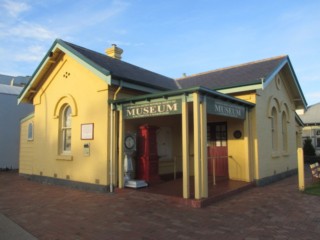Mornington Main Street Heritage Walk (Mornington)


The area was frequented by the Boonwurrung/Bunurong people and visited by Matthew Flinders in 1802. The first European settlers entered the area in the 1840s seeking timber and fish and taking up pastoral leases. A Government survey in 1854 of the area called Schnapper Point, after the headland, allowed for land sales. The township declared Mornington in 1861, was named after the 2nd Earl of Mornington who had been British Foreign Secretary. Mornington quickly became the major commercial and legal centre for townships and rural communities across the Peninsula.
By around 1910, Mornington had become a popular bayside destination for holiday makers. Steamers called at the jetty and the train had been running daily since 1889.
The road to Frankston was soon to bring the first motorists and buses, replacing the Cobb and Co. coaches.
Today's Main Street reflects the changing times over its history. The brochure takes you on a walk of sites of historical interest as shown by the plaques placed on significant buildings.
Sites covered in the brochure are Court House & Lock Up, Mornington Coffee Palace, Commercial Bank, Blake St & Corner, Railway Store, The Grand Hotel, Main St South, Old Fire Station, Plaza Cafe, Bradford Dairy, Livery & Coaching Stables, Oriental Bank & Allchin's Store, Males Butchery and the Hairdressers, Cottage/Billiard Room/Shop, Mechanic's Institute & RSL Club, Federal House, Old Post Office and the State Savings Bank.
Court House & Lock Up
Built by William Vaughan & Co in 1860 and extended in 1862, this is the oldest public building in Mornington and initially served the entire Peninsula. It remained the Mornington Court of Petty Sessions until 1988. From the earliest years, cases typically involved drunkenness, larceny and by-laws and later motoring offences. The Lock-Up served as a jail from 1862 until 1882. Subsequently it was used principally for holding people in custody overnight or during court sessions.

Old Post Office
Designed by William Wardell in Palladian Italian Renaissance style in polychrome brick and now covered with a cement render, it was built in 1863/4. Originally this fine building had a gabled entry porch and small verandah on its west-facing wall. Inside is
the original expansive wooden counter and fi replace and other fittings. The building replaced the original telegraph office which had been opened in 1861. The mail arrived from Melbourne by boat and was brought up from the pier by horse and cart to be sorted. Mornington's first telephone exchange opened in this building in 1905. The Post Office was transferred to new premises in 1963/64. This building was reopened in 1968 as a museum, exhibiting many objects tracing the history of the Mornington district as well as postal and communications memorabilia.

State Savings Bank
The bank and residence was built by J.C. Caldwell in Swiss chalet style and completed in 1912. Electric lighting was installed in 1923 . The State Savings Bank was known as 'The Farmers Bank' as it became a key source of farm finance, which was important for the largely rural community of the Peninsula. In 1954 the Bank moved to new premises in Main Street. It has been occupied by a variety of businesses including the first offices of the Mornington Crime Investigation Unit in 1977. Much of the original interior is preserved, including the pressed metal ceilings and the old fireplaces.

Federal House
Built in the late 1880s, the Federal Cash Store was run for many years by Robert Nunn, selling groceries, wines and spirits. The building also included a bakery. There was a residence above with a fine wrought iron verandah. Robert Nunn was a highly regarded businessman who became Shire President. Subsequently the store was converted into a guest house to meet the burgeoning holiday trade. In the early 1940s, it was advertised as a boarding house but also catered for weddings and offered meals. Bungalows were added in the back garden and the lounge on the first floor was also used as a meeting room. In 1949 as New Federal House it still maintained its original facade. In the 1950s it became The Federal Cafe.

The Grand Hotel
Built in 1889, this building began as the Grand Coffee Palace, one of many such establishments encouraged by the Temperance Movement. The architect was William Pitt who had designed the Windsor Hotel in Melbourne. The original building had three bays beneath a central tower and steeple with an arched carriageway to Swift's stables behind. Cornelius Crowley was the first owner. He also owned the Cricketer's Arms Hotel next door. This was built in 1868 with a decorative parapet of finials and urns. The liquor licence was transferred in the early 1890s from the Arms to the Coffee Palace which was then renamed the Grand Hotel. The Cricketer's Arms building then became a car hire and coach depot before being replaced by a furniture store in the late 1940s and then various businesses over the years. The Grand was expanded to its current size in 1919. The tower has always been a landmark feature in the town. The current design, constructed in 1987, is the third. The building retains its original distinctive French Renaissance revival style roof and some internal features.

The brochure (see link below) was produced by the Chamber of Commerce, Mornington to commemorate (150 years) of the declaration of the township of Mornington 1861-2011.
Records and photos may be viewed in the Old Post Office Museum, Cnr Main Street and Esplanade, Mornington.
Photos:
Location
Main Street, Mornington 3931 Map
Web Links
→ Mornington Main Street Heritage Walk (PDF)









